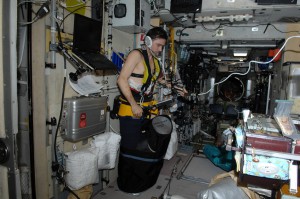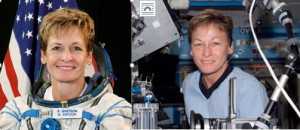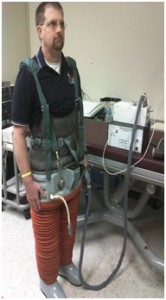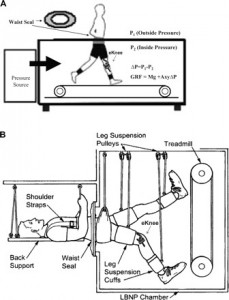The latest in astro-chic fashion aboard the International Space Station is sure to generate a lot of buzz – among scientists, at least. Where else can you get away with wearing rubber suction pants? While these pants look a little unusual, they may help us understand a potentially serious vision problem that affects some astronauts on long duration spaceflights.

The human body is roughly 70% fluids, which includes blood, lymph, and water contained within and around cells. On Earth, our cardiovascular system keeps those fluids distributed throughout our body despite the pull of gravity. During spaceflight, body fluids accumulate in the upper body, causing a noticeable puffiness in astronauts’ faces. This redistribution of fluids may be contributing to the aforementioned vision impairment.

The Russian Chibis suit is designed to counteract the tendency for fluids to pool in the upper body by applying lower body negative pressure (LBNP). Chibis works like a household vacuum cleaner to suck astronauts into the pants, load the bottoms of their feet, and expand veins and tissues of the lower body. By sucking blood and other body fluids back to the lower body, swelling in the face and elevated pressure in heads of astronauts may be avoided.
During the one-year mission recently embarked upon by American Astronaut Scott Kelly and Russian Cosmonaut Mikhail Kornienko, a new investigation called Fluid Shifts seeks to test the relationship between the head-ward fluid shift and a pattern NASA calls visual impairment and intracranial pressure syndrome, or VIIP. VIIP involves changes in vision, the structure of the eyes and indirect signs of increased pressure in the brain. More than half of American astronauts have experienced VIIP symptoms during long spaceflights.
A unique aspect of the Fluid Shifts investigation is the use of the Russian Chibis suit, namely LBNP, during cardiovascular and VIIP-related physiological measurements. Precursors of LBNP actually include the ancient practices of bloodletting and cupping to alter blood volume and pressure in the sick. The first true use of LBNP was in the early 1950s, and it was widely used as a research tool to study the cardiovascular system in the 1960s. The Chibis suit was first used in spaceflight during the Salyut space station missions and has been used regularly late in missions as part of the cosmonauts’ health program to prepare them for return to Earth.
Exercise devices presently aboard ISS such as the cycle ergometer and treadmill provide a cardiovascular workout, but they are not designed to move blood and body fluids back toward the feet. LBNP stresses the cardiovascular and musculoskeletal systems in a way that is similar to standing and exercising on Earth. In a way, LBNP is an artificial gravity device.

In fact, the Fluid Shifts investigation may result in design of future space exploration exercise devices that simulate gravity and shift fluid to the lower body. Such a device may provide an integrative system for protecting astronauts across multiple physiologic systems prior to incorporation of more advanced concepts of artificial gravity such as a rotating spacecraft or a centrifuge.
The Fluid Shifts investigation has Earth benefits for health applications as well. Results may improve our understanding of how blood pressure in the brain affects eye shape and vision which could also benefit people confined to long-term bed rest, or suffering from disease states that increase swelling and pressure in the brain.
By now, you are no doubt wondering where you can get your own pair of rubber suction pants. You’re in luck! By using suction in exercise equipment on the ground, athletes can be trained at higher weight-bearing levels to improve their performance. Also, using positive pressure in a lower body chamber, elderly patients and people with leg injuries can be brought back to normal daily activities and “peak performance” earlier than possible with present modes of rehabilitation.

The Clinical Orthopaedic Lab at the University of California, San Diego has been involved in spaceflight cardiovascular, bone and muscle research for over 30 years; and we are particularly excited to be a part of the international team of investigators involved in the Fluid Shifts investigation. While unlikely to start a new fashion trend, we look forward to sharing the important results from the rubber vacuum pants that suck.

Alan Hargens PhD., previously served as Chief of the Space Physiology Branch and Space Station Project Scientist at NASA Ames Research Center (1987-2000) and Consulting Professor of Human Biology at Stanford University (1988-2000). His recent research concerns gravity effects on the cardiovascular and musculoskeletal systems of humans and animals.
